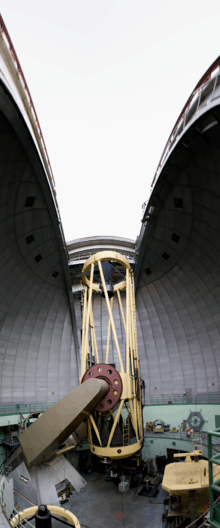C. Donald Shane telescope
 C. Donald Shane 3m telescope at the Lick observatory on Mt. Hamilton, San Jose, California - as seen from inside the dome. | |
| Named after |
C. Donald Shane |
|---|---|
| Observatory |
Lick Observatory |
| Location(s) | United States |
| Coordinates |
37°20′35″N 121°38′14″W / 37.343036°N 121.637136°WCoordinates: 37°20′35″N 121°38′14″W / 37.343036°N 121.637136°W |
| Telescope style |
Optical telescope |
| Website |
www |
 Location of C. Donald Shane telescope | |
The C. Donald Shane telescope is a 120-inch (3.0-meter) reflecting telescope located at the Lick Observatory in San Jose, California. It was named after astronomer C. Donald Shane in 1978, who led the effort to acquire the necessary funds from the California Legislature, and who then oversaw the telescope's construction. It is the largest and most powerful telescope at the Lick Observatory, and was the second-largest telescope in the world when it was commissioned in 1959.[1]
The Shane's mirror started as a 10,000-pound Corning Labs glass test blank for the Palomar Observatory's 200-inch (5-m) Hale telescope (in north San Diego County, California), but was sold below cost ($50,000)[1] by Caltech to the Lick Observatory.[1] It was then transported to Mount Hamilton, where the blank was ground and polished by the observatory.[1]
Features
The telescope can be used with three different focal stations: wide field prime focus, coudé focus for high precision spectroscopy, or the intermediate cassegrain focus.
In the Shane dome there is a laser, whose light is sometimes visible with the naked eye, that the observatory beams from the Shane telescope into the night sky. The laser is part of the Lick Adaptive Optics (LAO) program, a joint project of the Lick Observatory and the Lawrence Livermore National Laboratory. LAO corrects for atmospheric turbulence either by using a natural guide star or by creating a sodium laser guide star, and using the observed motion of the guide star to direct distortion of a deformable mirror hundreds of times each second. The system produces images that are nearly equivalent to those obtained from space-based telescopes. Adaptive optics using natural guide stars has been in development since 1996, and using laser guide stars since 2001. Similar laser adaptive optics systems based on LAO have been installed on the University of California's two Keck telescopes in Hawaii.
Instrumentation currently in operation at the Shane telescope includes:[2]
- The Kast Double Spectrograph, used for visible wavelength observations of stars, supernovae, galaxies, and active galactic nuclei
- The Hamilton Spectrograph, an echelle spectrograph used for stellar spectroscopy and detection of exoplanets
- The Shane Adaptive optics infra-Red Camera Spectrograph (ShARCS), an infrared camera used with the Shane adaptive optics system[3]
History
For Lick Observatory's first 55 years of operation, its astronomers relied on two telescopes built in the 19th century. Once considered giants in the field, they had become obsolete. International competition was mounting. The 120-inch reflector addition took 15 years to complete, being completed in 1959. It would be the second-largest telescope in the world, taking its place behind the then enormous 200-inch Palomar Hale Telescope.
Contemporaries on commissioning
The Shane telescope saw first light to a different world for large telescopes in 1959:
| # | Name / Observatory |
Image | Aperture | Altitude | First Light |
Special advocate |
|---|---|---|---|---|---|---|
| 1 | Hale Telescope Palomar Obs. |
200 inch 508 cm |
1713 m (5620 ft) |
1948 | George Ellery Hale John D. Rockefeller | |
| 2 | Shane Telescope Lick Observatory |
120 inch 305 cm |
1283 m (4209 ft) |
1959 | Nicholas Mayall C. Donald Shane | |
| 3 | Hooker Telescope Mount Wilson Obs. |
100 inch 254 cm |
1742 m (5715 ft) |
1917 | George Ellery Hale Andrew Carnegie | |
| 4 | Otto Struve Telescope McDonald Obs. |
82 inch 210 cm |
2,070 m 6791 ft |
1939 | Otto Struve |
See also
References
- 1 2 3 4 Mt. Hamilton Telescopes: Carnegie Double Astrograph
- ↑ "Lick Observatory Shane Telescope web site". Retrieved 25 January 2017.
- ↑ McGurk, Rosalie; et al. (2014). "Commissioning ShARCS: the Shane Adaptive optics infraRed Camera-Spectrograph for the Lick Observatory 3-m telescope". Proceedings of the SPIE. 9148: 91483A. arXiv:1407.8205. doi:10.1117/12.2057027. Retrieved 25 January 2017.